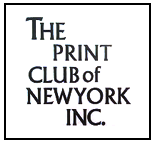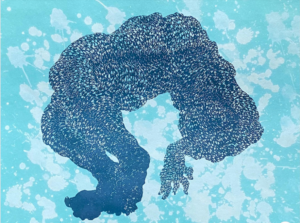ARTIST: Didier William
TITLE AND EDITION: Vol, edition size 200 plus 1 Archive Print, 5 Artist Proofs, and 2 Printers Proofs
DATE: 2022
MEDIUM: Letterpress printed relief from wood carving and polymer plate
PAPER: 100 lb French Paper
PRINT DIMENSIONS: 12 ½ inches × 19 inches
Didier William on the development of the 2022 Presentation Print, Vol:
This print shares its title with a painting of a similar composition. In Haitian Kreyol “vol” means flight. In my practice over the last few years, I have been considering different spaces and places to serve as the arena or stage for the narratives that make up my images. Most often these have included scenes depicted within bodies of water, scenes of submersion, and bodies in flight or suspended. The print depicts an idealized singular body left groundless but for bleached blue abstraction that serves as its container within the composition. On closer inspection the viewer will notice that the body is composed of carved eyes. Once close enough to make out the eye forms, they are made aware that they too have become the subject of the figures’ seemingly infinite gaze.
Artist’s Statement:
My paintings image the resultant network that is formed when myth, Afro-Caribbean history, and personal narrative combine. The carved eyes in my paintings conscript the viewer into a flamboyant narrative made deliberately queer by refusing explicit sex and gender signifiers. In order to destabilize the performance of gender as a kind of cultural evidence of sex and sexuality, my bodies are intentionally void of such indicators. Similarly, they slip out of easily racialized categories and instead insist on a circuit of active looking between them and the viewer. In a manner akin to science fiction, viewers are forced to contend with a dissociated body; a body that is cloaked, patterned, adorned, and perhaps even consumed by diversionary tactics.
Influenced by my upbringing in Miami, the places in my paintings are informed by the psychosocial spaces occupied by diaspora communities. My work has always engaged in imagining unconventional bodies and specifically questions black and queer identity formation. I combine, collide, and collapse printmaking, painting, collage, and drawing materials and techniques into the surfaces of my obiects. I draw from historical content, Haitian vodou symbolism, and personal narratives to inform not only my research but also my material choices. More recently, boundaries and edges have become camouflaged within one another. In this way, their alternative presence both denies and reaffirms physical bodies. Their multiplicity speaks to their omnipresence and extends them into the grounds they occupy. The acts of figurative distortion, collage/patterning, and ornamentation synchronize to form a permeable membrane between the psychological body and its failed anatomy. My surfaces – where the bodies are formed through cuts, stains, and the residue of historical narratives – become sites of convergence and collision, marking both the fragility and the persistence of black humanity.
At stake in my work is an investigation of the expansive potentials embedded in the languages of representation. The capacity for visual language to communicate something to the viewer extends so formal and conceptual ancestors: Robert Colescott, Belkis Ayon, and Helen Frankenthaler, just to name a few, understood this quite well and exploited what I would call a “thoughtful divergence” in the same painting. Marks, gestures, shapes, and surfaces remain forcefully physical and tactile even as their symbolism is embedded with cultural meaning and made textual.
As an immigrant in this country, the simultaneous histories of my birthplace and my present are constantly interwoven to build a forcefully temporal construction of home. For me this necessarily changes both the function of, and the expectations for representation. It opens up a space for magical realism, surrealism, geometric abstraction, naturalism, and even digital systems-based processes that conspire to build a more accurate, more felt, and perhaps more honest version of history.

